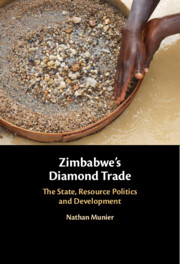Refine search
Actions for selected content:
160 results
1 - The Diamond Curse in Zimbabwe
-
- Book:
- Zimbabwe's Diamond Trade
- Published online:
- 06 November 2025
- Print publication:
- 04 December 2025, pp 1-22
-
- Chapter
- Export citation
3 - The Ownership Structure of Zimbabwe’s Diamond Sector
-
- Book:
- Zimbabwe's Diamond Trade
- Published online:
- 06 November 2025
- Print publication:
- 04 December 2025, pp 52-73
-
- Chapter
- Export citation
7 - Resource Wealth and the Opaque State
-
- Book:
- Zimbabwe's Diamond Trade
- Published online:
- 06 November 2025
- Print publication:
- 04 December 2025, pp 141-157
-
- Chapter
- Export citation
The middle-income trap, state capacity, and institutional business power: understanding the failed upgrading of the lithium industry in Chile – ERRATUM
-
- Journal:
- Business and Politics , First View
- Published online by Cambridge University Press:
- 03 December 2025, p. 1
-
- Article
-
- You have access
- Open access
- HTML
- Export citation

Zimbabwe's Diamond Trade
- The State, Resource Politics and Development
-
- Published online:
- 06 November 2025
- Print publication:
- 04 December 2025
3 - Hierarchy, Property Rights, and State Capacity
-
- Book:
- Hierarchy and the State
- Published online:
- 20 August 2025
- Print publication:
- 02 October 2025, pp 41-64
-
- Chapter
- Export citation
Weather shocks and capital flight
-
- Journal:
- Environment and Development Economics , First View
- Published online by Cambridge University Press:
- 20 August 2025, pp. 1-20
-
- Article
- Export citation
Criminal Governance in Latin America: Prevalence and Correlates
-
- Journal:
- Perspectives on Politics , First View
- Published online by Cambridge University Press:
- 12 August 2025, pp. 1-19
-
- Article
-
- You have access
- Open access
- HTML
- Export citation

The Undulating Capacity of the State
- Autochthony and Infrastructure Development in African Cities
-
- Published online:
- 11 August 2025
- Print publication:
- 04 September 2025
-
- Element
- Export citation
The middle-income trap, state capacity, and institutional business power: understanding the failed upgrading of the lithium industry in Chile
-
- Journal:
- Business and Politics , First View
- Published online by Cambridge University Press:
- 28 July 2025, pp. 1-25
-
- Article
-
- You have access
- Open access
- HTML
- Export citation
9 - The Political Economy of India’s Corporate Social Responsibility Reforms
-
-
- Book:
- Legal Heterodoxy in the Global South
- Published online:
- 19 June 2025
- Print publication:
- 03 July 2025, pp 274-298
-
- Chapter
-
- You have access
- Open access
- HTML
- Export citation
Critical Human Security, State Capacity, and Post-Pandemic Policy Challenges in Europe and East Asia
-
- Journal:
- Social Policy and Society / Volume 24 / Issue 3 / July 2025
- Published online by Cambridge University Press:
- 18 July 2025, pp. 449-466
- Print publication:
- July 2025
-
- Article
-
- You have access
- Open access
- HTML
- Export citation
Vulnerability and Critical Human Security in the Era of COVID-19 and Beyond in the UK and South Korea – ERRATUM
-
- Journal:
- Social Policy and Society / Volume 24 / Issue 3 / July 2025
- Published online by Cambridge University Press:
- 12 September 2025, p. 498
- Print publication:
- July 2025
-
- Article
-
- You have access
- Open access
- HTML
- Export citation
Critical Human Security, State Capacity, and Policy Challenges in a Post-Covid-19 World: South Korea and the UK
-
- Journal:
- Social Policy and Society / Volume 24 / Issue 3 / July 2025
- Published online by Cambridge University Press:
- 17 July 2025, pp. 444-448
- Print publication:
- July 2025
-
- Article
- Export citation
5 - Natural Resources and Intrastate Conflict
-
- Book:
- Civil War and Intrastate Armed Conflict
- Published online:
- 29 May 2025
- Print publication:
- 12 June 2025, pp 144-185
-
- Chapter
- Export citation
Some Useful Resources
-
- Journal:
- Social Policy and Society / Volume 24 / Issue 3 / July 2025
- Published online by Cambridge University Press:
- 19 May 2025, pp. 535-536
- Print publication:
- July 2025
-
- Article
-
- You have access
- Export citation
4 - State Capacity and Accountability in Low-Income States
- from Part I - Institutional Dimensions of Democratic Backsliding and Resilience
-
-
- Book:
- Global Challenges to Democracy
- Published online:
- 01 May 2025
- Print publication:
- 15 May 2025, pp 71-88
-
- Chapter
- Export citation
Learning like a state organizational learning and state capacity in ancient Greece
-
- Journal:
- Journal of Institutional Economics / Volume 21 / 2025
- Published online by Cambridge University Press:
- 13 May 2025, e17
-
- Article
-
- You have access
- Open access
- HTML
- Export citation
Do welfare states have lower carbon emissions? The importance of state capacity in lower-income countries
-
- Journal:
- Journal of Public Policy / Volume 45 / Issue 3 / September 2025
- Published online by Cambridge University Press:
- 13 May 2025, pp. 428-448
-
- Article
-
- You have access
- Open access
- HTML
- Export citation
On mechanisms of meritocratic recruitment: competence and impartiality
-
- Journal:
- Journal of Institutional Economics / Volume 21 / 2025
- Published online by Cambridge University Press:
- 10 April 2025, e12
-
- Article
-
- You have access
- Open access
- HTML
- Export citation
